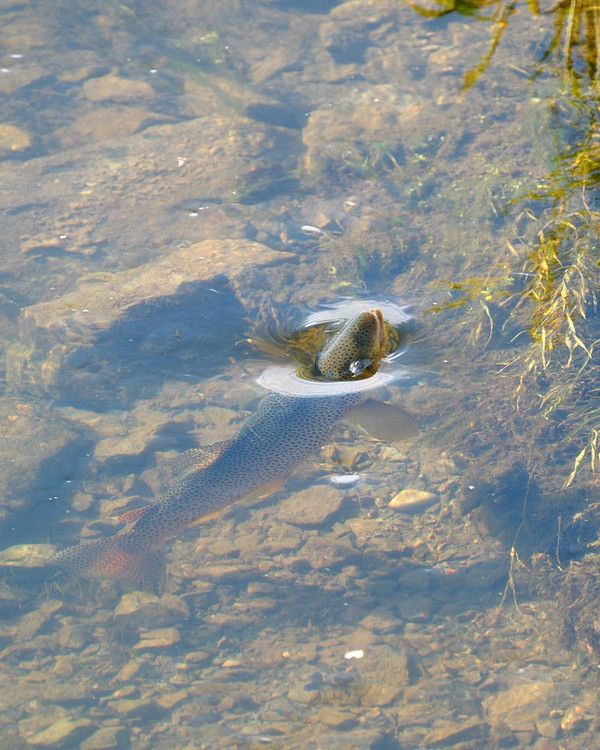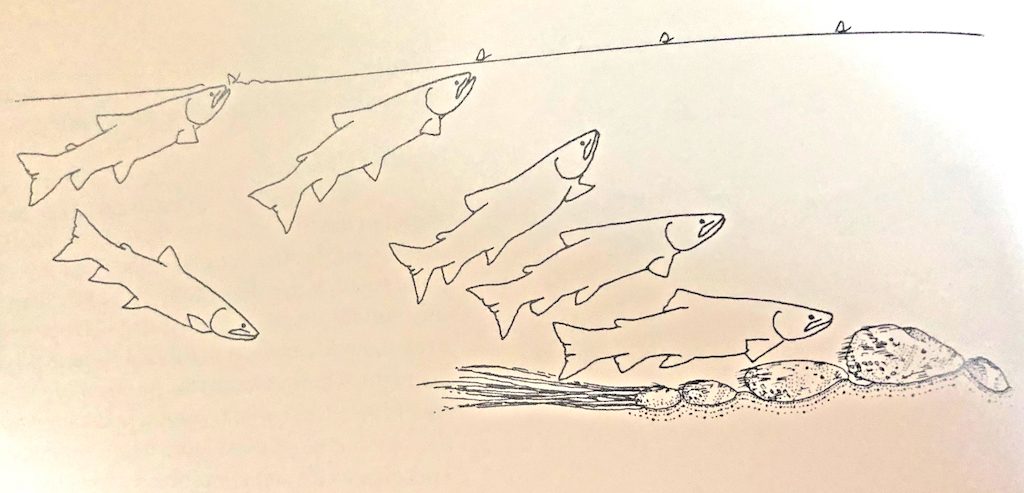When a trout feeds on or near the surface, it creates a ring in the water that can appear as a violent splash or a mere dimple. Recognizing certain characteristics of this rise ring can tell you a lot about where the fish is positioned, where his feeding lane is, his size and possibly what he’s feeding on.
Lengthy chapters of vast and detailed information on this topic can be found in a number of well known fly fishing books. I recommend reading them. This article will attempt to condense that information into a useful overview. As always, these are general rules to which there are always exceptions!

Common or Simple Rise
A common rise is characterized by a quick view of the trout’s head, dorsal fin, and often “wagging” tail, followed by a boil of water. It indicates that the trout is positioned near the surface and feeding on insects on the surface or near the surface film. The insects are probably medium to large in size. Because of the increased exposure to predators, trout rarely position themselves near the surface unless there is a lot of food available. So, if you see this kind of rise, keep watching. Chances are you will see the same fish repeatedly feeding.
Surface Swirl
The surface swirl is similar to the common rise but without the appearance of the head, fin or tail. You only see the water boil. In this case, the fish is probably positioned within a foot or two of the surface and is feeding on insects at least two inches below the surface. You can spend hours casting dry flies to these kind of rises without a take, but an unweighted nymph or wet fly fished just below the surface can be deadly.
Poking or Dimple Rise
As the name implies, this rise form appears as just a dimple on the surface and if you look carefully, you can often see just the nose of the trout penetrate the surface. This rise form also suggests the trout is positioned near the surface but likely feeding on small insects on or just below the surface. This type of rise is most often seen in slower pools and runs, slow edges of currents and eddies.
Splashy Rise
When a rise ring is more of a splash, it can mean a few things. Usually, it just indicates that the trout is positioned deeper in the water. By traveling farther up the column for food, the trout’s momentum often results in more of a splash on the surface. If the trout is positioned deeper, this was likely an opportunistic rise from a fish not necessarily focused on the surface. You may never see him come up again.
Similarly, trout feeding on insects that emerge and get off the water quickly can display a splashier rise. Caddis flies fit this description, so many anglers assume (sometimes incorrectly) that a splashy rise means trout are feeding on caddis. And sometimes a splashy rise can simply be the result of a smaller, eager trout rising recklessly.
Gulping Rise
A gulping rise is like a greatly exaggerated common rise. The trout’s mouth is wide open and his entire backside breaks the surface, followed by an often audible “gulp.” You’re likely to see this type of rise during very heavy hatches when there are frequently multiple bugs very close together on the surface. The trout may eat as many as six bugs in one rise. If you’re seeing this, you’re at the right place at the right time. Try to match what you see on the water and don’t get your leader in a big tangle!
Jumping Rise
A jumping rise is when the trout completely clears the water, sometimes by a few feet! This could mean the fish is feeding on bugs in the air just above the surface, or possibly something large like a mouse or even baitfish. In any case, a jumping rise suggests a brief moment of opportunity and not a steadily feeding trout. I don’t recall ever standing in a pool and seeing dozens of trout routinely jumping out of the water. Most experienced anglers recognize the jumping rise as fool’s gold, shake their heads and move on.
Where is the trout?
As mentioned above, certain types of rise rings can suggest how deep the trout may be. However, there are other things to consider when determining where in the stream that trout is positioned.

First and foremost, when a trout rises in a stream, he is going to drift back during the process, then return to his original position. So the trout is actually positioned upstream of where you saw him rise. If he is holding near the surface, his position may only be a few inches upstream of the rise. If he’s holding in deeper water, his position may be several feet upstream of the rise.
When a trout rises, you’re also going to see a “push” of water, like a little wave. That wave usually pushes upstream. But if the wave pushes to one side or another, it indicates that the trout came over to feed. So, he may be holding in one lane and feeding in another.
There’s a lot to this, I know. The best advice I can offer is when you see a trout rise, don’t immediately cast a dry fly to that spot. Think about what the rise looked like and stop and look for others. Identifying rise rings may not give you all the answers, but it will give you a great place to start!

